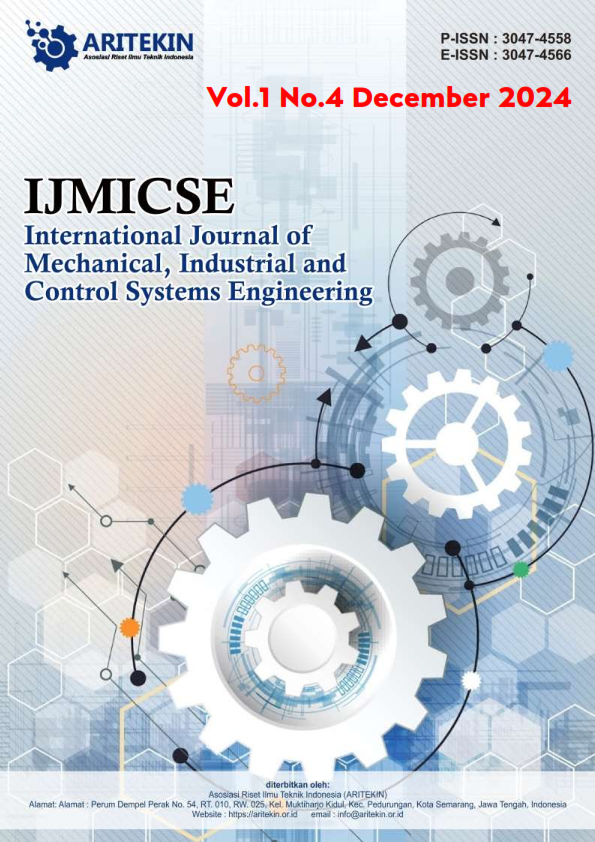Optimization of Production of A350 Aircraft Wing Components With Interpretive Structural Modeling Diagram at PT XYZ
DOI:
https://doi.org/10.61132/ijmicse.v1i4.132Keywords:
Airbus A350, Interpretive Structural Modeling, Production Efficiency, System ModelingAbstract
PT XYZ, which aims to optimize the production process of Airbus A350 aircraft wing components. The background of this research focuses on the importance of efficiency and effectiveness in the aviation industry, where each component must be produced to high standards to ensure aircraft safety and performance. In order to achieve this goal, the author applies several methods for completing the task, including system modeling and Interpretive Structural Modeling (ISM). This method allows for in-depth analysis of the structure and relationships between elements in the production system. Data processing is carried out through four main stages: model concept design, data collection, analysis, and evaluation. The raw data used includes the company layout and wing component production flow. The results of this data processing provide significant insights into potential improvements in the existing production system, as well as recommendations for improving operational efficiency. Thus, this report not only contributes to the development of knowledge in the field of systems engineering, but also provides practical advice for PT XYZ to improve their production performance.
References
Alam, P. (2019). Modeling and simulation of manufacturing industrial systems using hybrid simulation methods (Case study: PT. Manage Mina Laut). ITS Engineering Journal, 6(2).
Anna, S. (2020). Modeling of fisheries and marine resources. Gramedia Pustaka Utama.
Fahrezi, M. F. (2018). Modeling of the dynamic tofu production system at UD Toha Jaya, Tamanan District, Bondowoso Regency [Thesis]. Jember State Polytechnic.
Hayati, N., & Lionie, L. (2023). Web-based design of new student admission information system for Izzatul Madani Islamic Junior High School Bogor. Journal of Technology and Information, 13(2), 165–180. https://doi.org/10.34010/jati.v13i2.10199
Pahleviannur, M. R., Grave, A. D., Sinthania, D., Hafrida, L., Bano, V. O., & Saputra, D. N. (2022). Qualitative research methodology. Pradina Pustaka.
Patrobas, G., Hassan, A., & Pondaag, J. (2021). Analysis of coconut flour production planning with the aggregate planning method at PT. Tropica Coco Prima in Lelema Minahasa Selatan. Journal of EMBA, 9(3), 1173–1182.
Rahmadani, A., Ramadhanti, C., & Pramestiana, I. (2022). Analysis of production planning with double moving average and Holt methods on CV. Putra Hari Cibitung. Journal of Logistics & Supply Chain Center, 1(1), 18–26.
Suwandi. (2021). Simulation of production machines in the fibercement roof industry using the Promodel application.
Triwibisono, C., & Aurachman, R. (2020). Solving the problem of traffic congestion at the intersection of Sukarno Hatta – Buah Batu Bandung with a computer simulation method. Journal of Industrial Management and Logistics, 4(1), 75–83. https://doi.org/10.30988/jmil.v4i1.324
Wardhana, A. D. (2018). Modeling of the dynamic system of shredded production at UD Rama, Jember Regency [Thesis]. Jember State Polytechnic.
Yani, A. (2020). Analysis of aggregate planning with transportation methods for cost optimization (Study on SMEs of women's bag products). Journal of Economics, Business, and Industry (EBI), 2(2), 1–10.
Downloads
Published
How to Cite
Issue
Section
License
Copyright (c) 2024 International Journal of Mechanical, Industrial and Control Systems Engineering

This work is licensed under a Creative Commons Attribution-ShareAlike 4.0 International License.





